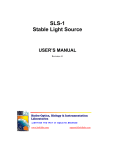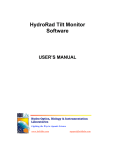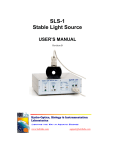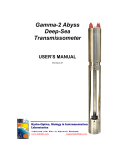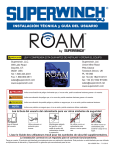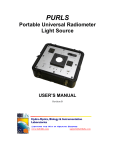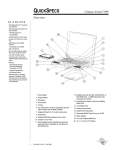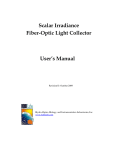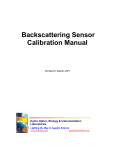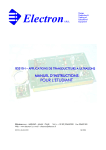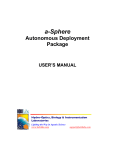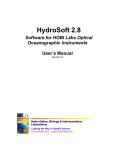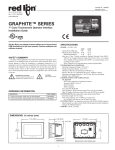Download HydroPack Manual C - Hobi Instrument Services
Transcript
HydroPack Submersible Battery Pack USER’S MANUAL Rev C H Hyyd drroo--O Op pttiiccss,, B Biioollooggyy & & IIn nssttrru um meen nttaattiioon n L Laabboorraattoorriieess Lighting the Way in Aquatic Science www.hobilabs.com [email protected] Revisions Rev C November 2009, Update illustrations, add information about multiple packs, update capacity table based on recent Energizer spec sheet. Rev B October 2009, Changed pinout Rev A July 2008, Reformatted April 5, 2002: First Release 2 1. INTRODUCTION HydroPack is a submersible battery pack that uses commonly available D cells for high-power or long-endurance oceanographic deployments. 20 cells are wired in two groups of 10 cells each, providing a nominal output of 12 to 15V and capacity of up to 30Ahr (see further notes in section 3.4). Diodes prevent harmful interactions between the cell groups and also allow multiple HydroPacks to be safely paralleled (with appropriate cables). Each cell group is protected with a 2.5A resettable fuse. In the event of an overload or short circuit, the fuse will activate and reduce the current to a low level. Once the fault condition is removed, the fuse will return to its normal state in a short time. The HydroPack case is made from type 316 stainless steel and acetal plastic to prevent corrosion. It is also equipped with a pressure relief valve that limits internal pressure build-up in case of a fault condition such as a water leak or gas generation by the batteries. 2. PRECAUTIONS • Always inspect o-rings and grooves before deployment, and replace the o-rings if in doubt about their condition. • Use care to avoid short circuits when connecting multiple packs with Ycables (see Figure 4). • Replace all cells at the same time with fresh cells of the same type. • Remove batteries before shipping the packs or storing them. 3 3. OPERATION 3.1. Connecting The HydroPack uses an Impulse or SubConn MCBH2F connector. Mate to this using an MCIL2M inline connector. Pin 2 is positive, and pin 1 is the return. NOTE: This pinout has changed from earlier HydroPacks. Units delivered up to October, 2009 had opposite polarities. 3.2. Removing Batteries Remove the endcap by inserting a 3/16” hex wrench into the bolt head in the center of the end cap (the off-center bolt is the pressure relief valve), and turning it counter clockwise until the end cap is free. To remove the old batteries you can simply tip the HydroPack to dump them out. If this is not practical, you can instead remove the top layer of batteries, one at a time, then grasp two of the outer rods and lift the rod assembly up to remove the lower layers as shown in Figure 1 (only Series 150 or later HydroPacks have removable rod assemblies). 3.3. End Cap Inspection and Maintenance Figure 1. Using rod assembly to lift batteries from pack (Series 150 HydroPacks only) Whenever you remove the end cap, inspect the o-rings and the inner surface of the case where the o-rings seal, to be sure they are free of damage and contamination. If the o-rings may have become dirty during handling, remove them from their grooves and clean both them and the grooves. Do not use any hard, sharp or abrasive objects on the o-rings or their grooves. The o-rings should be slightly slippery. If not, apply a very light coating of an appropriate lubricant such as Dow Corning 55 or Parker O-Lube. 4 If the threads of the end cap’s retaining screw do not run smoothly when you remove and replace the end cap, apply a small quantity of anti-seize lubricant or silicone grease to them. Check that the pressure relief valve (the off-center bolt in the end cap) is seated properly and does not protrude. 3.4. Preparing for Deployment In Series 150 or later packs, be sure the removable post assembly is resting flat on the bottom of the pack before inserting batteries. Insert new batteries with their positive (button) side facing the open end of the tube, as in Figure 2. It is safe to let the batteries slide down into the pack if it is standing vertically. Always replace the entire set of batteries at once. Figure 2. Cell orientation Mixing batteries of different types, or different states of charge, can lead to battery leakage and failure. Position the end cap over the open end of the case, with the large springs centered on the battery tops and the small springs on posts positioned to contact the posts between the batteries (see Figure 3). Without rotating the cap, place it on the end of the case. While holding the cap to prevent it from rotating, tighten the center bolt with the 3/16” hex wrench. Tighten the bolt enough to ensure that the lid is resting firmly on the tube, with no gap between the end cap flange and the tube, but do not apply more than moderate hand torque. 3.5. Energy Capacity The actual energy capacity of Figure 3. Correct end cap position for installation alkaline batteries varies greatly depending on how heavily they are loaded, whether 5 the load is continuous or intermittent, the temperature at which they are discharged, and the minimum voltage suitable for the load. It is difficult to accurately model all these effects, so one should always estimate conservatively, and if possible run tests under realistic conditions. The highest capacity alkaline D-cells currently available claim capacities of 18 Ahr, based on very favorable test conditions: room temperature, a light load of 25mA, and an ending voltage of 0.8V per cell. Because the HydroPack contains 2 paralleled groups of 10 cells, this corresponds to totals of 36 Ahr and about 7.5V (0.8V x 10 cells minus one diode voltage drop). However the actual capacity will be significantly lower Load Capacity (mA) (Ahr) 20 30 100 28 200 22 400 20 600 18 800 14 1000 10 with heavier loads or lower temperatures. The table at left uses figures derived from the data sheet for Energizer type EN95 D cells. They are based on an ending voltage of 1.05 V/cell (10V output from the HydroPack), and continuous discharge at 21 C. The capacity can be expected to drop at lower temperatures, to about one-half of these values at 5 C. For a given current load, especially for higher loads, intermittent use can provide significantly higher total capacity than continuous use. For example, at a current load of 1 A, reducing the duty cycle to 2 minutes per hour provides roughly 50% more total charge than continuous use. The discrepancy between intermittent and continuous use decreases at lower loads; at 50 mA or less there is no significant difference. 3.6. Using Multiple Packs Multiple HydroPacks can safely be wired together to increase their total capacity for heavy loads or longer durations. Because each HydroPack contains diodes to prevent reverse current flow, simple Y-cables can be used to connect them in parallel. WARNING: When plugging two packs together with a Y-cable (see Figure 4), once the first pack has been connected, its voltage is present on the male connector for the second pack, and vulnerable to short circuits. To avoid this, ALWAYS plug or unplug the second leg of the Y immediately after the first. 6 Figure 4. Beware: when one leg of the Y is plugged into a pack, the second plug is live. 7 4. SPECIFICATIONS • Diameter: 9 cm (3.5”) • Length: 37 cm (14.5”), not including connector • Materials: 316 stainless steel and acetal copolymer • Weight, with batteries: 5.3 kg dry, 2.5 kg submerged • Cell capacity: 20 D cells • Depth rating: see the warranty sheet supplied with your HydroPack or the label on Series 150 or later units. • Battery configuration: 2 series strings of 10 cells, each with a high-efficiency diode to prevent reverse current, and a 2.5A self-resetting fuse to protect against overload. • Output voltage: 16V max (with fresh alkaline cells) • Connector: MCBH2F, 2-pin female. o NOTE: These pin assignments were different for units delivered up to October, 2009 o Pin 1 = return o Pin 2 = positive voltage • 5. O-rings: 2-151 (inner), 2-235 (outer) CUSTOMER SERVICE If your equipment needs to be returned to HOBI Labs for repair, maintenance or calibration, contact HOBI Labs customer service ([email protected]), or fill out an RMA request form at www.hobilabs.com. For technical support or questions about your instrument, contact our technical support department at [email protected]. 8








